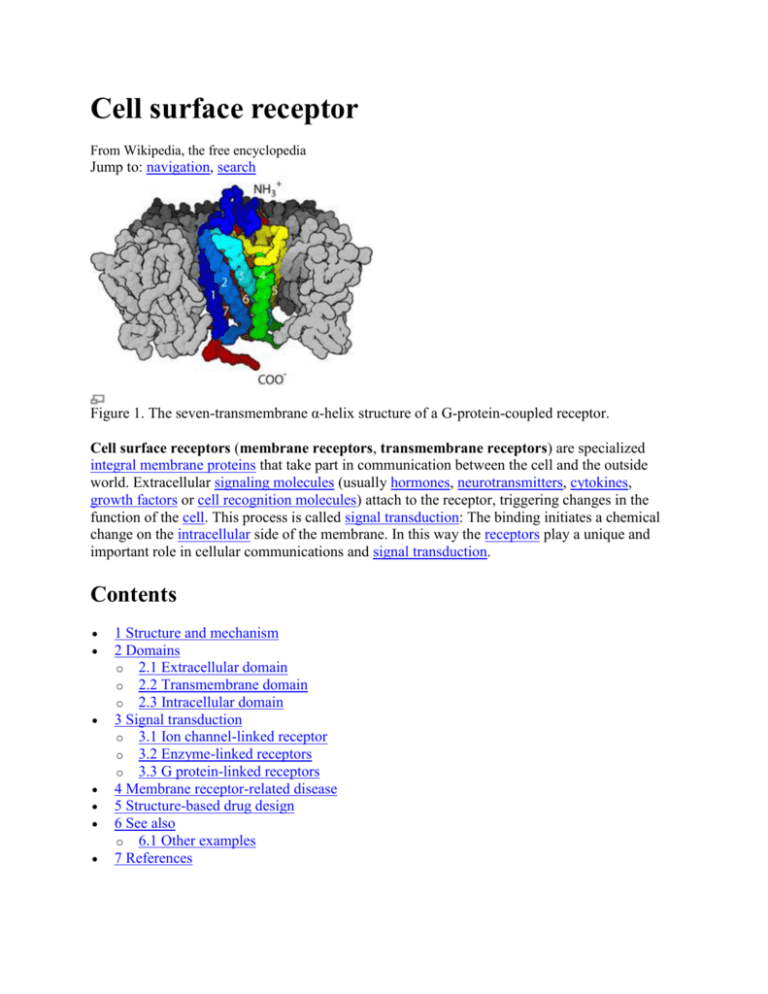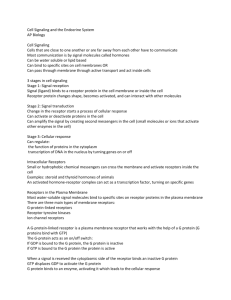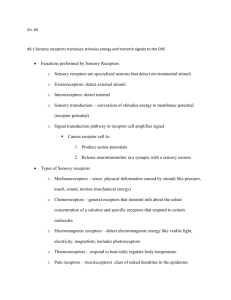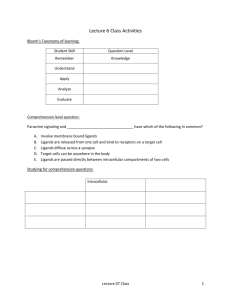Cell surface receptor
advertisement

Cell surface receptor From Wikipedia, the free encyclopedia Jump to: navigation, search Figure 1. The seven-transmembrane α-helix structure of a G-protein-coupled receptor. Cell surface receptors (membrane receptors, transmembrane receptors) are specialized integral membrane proteins that take part in communication between the cell and the outside world. Extracellular signaling molecules (usually hormones, neurotransmitters, cytokines, growth factors or cell recognition molecules) attach to the receptor, triggering changes in the function of the cell. This process is called signal transduction: The binding initiates a chemical change on the intracellular side of the membrane. In this way the receptors play a unique and important role in cellular communications and signal transduction. Contents 1 Structure and mechanism 2 Domains o 2.1 Extracellular domain o 2.2 Transmembrane domain o 2.3 Intracellular domain 3 Signal transduction o 3.1 Ion channel-linked receptor o 3.2 Enzyme-linked receptors o 3.3 G protein-linked receptors 4 Membrane receptor-related disease 5 Structure-based drug design 6 See also o 6.1 Other examples 7 References 8 External links [edit] Structure and mechanism Many transmembrane receptors are composed of two or more protein subunits which operate collectively and may dissociate when ligands bind, fall off, or at another stage of their "activation" cycles. They are often classified based on their molecular structure, or because the structure is unknown in any detail for all but a few receptors, based on their hypothesized (and sometimes experimentally verified) membrane topology. The polypeptide chains of the simplest are predicted to cross the lipid bilayer only once, while others cross as many as seven times (for example, the so-called G-protein coupled receptors). There are various kinds, such as glycoprotein and lipoprotein.[1] Hundreds of different receptors are known and many more are yet to be discovered.[2][3] Almost all known membrane receptors are transmembrane proteins. A certain cell membrane can have several membrane receptors with various amounts on its surface. A certain receptor may also exist at varying concentrations on different membrane surfaces, depending on the membrane and cell function. Since receptors usually form “clusters” on the membrane surface,[4][5] the distribution of receptors on membrane surface is mostly heterogeneous. [edit] Domains E = extracellular space P = plasma membrane I = intracellular space Like any integral membrane protein, a transmembrane receptor may be subdivided into three parts or domains. [edit] Extracellular domain The extracellular domain is the part of the receptor that sticks out of the membrane on the outside of the cell or organelle. If the polypeptide chain of the receptor crosses the bilayer several times, the external domain can comprise several "loops" sticking out of the membrane. By definition, a receptor's main function is to recognize and respond to a specific ligand, for example, a neurotransmitter or hormone (although certain receptors respond also to changes in transmembrane potential), and in many receptors these ligands bind to the extracellular domain. [edit] Transmembrane domain Main article: Transmembrane domain In the majority of receptors for which structural evidence exists, transmembrane alpha helices make up most of the transmembrane domain. In certain receptors, such as the nicotinic acetylcholine receptor, the transmembrane domain forms a protein-lined pore through the membrane, or ion channel. Upon activation of an extracellular domain by binding of the appropriate ligand, the pore becomes accessible to ions, which then pass through. In other receptors, the transmembrane domains are presumed to undergo a conformational change upon binding, which exerts an effect intracellularly. In some receptors, such as members of the 7TM superfamily, the transmembrane domain may contain the ligand binding pocket (evidence for this and for much of what else is known about this class of receptors is based in part on studies of bacteriorhodopsin, the detailed structure of which has been determined by crystallography). [edit] Intracellular domain The intracellular (or cytoplasmic) domain of the receptor interacts with the interior of the cell or organelle, relaying the signal. There are two fundamentally different ways for this interaction: The intracellular domain communicates via specific protein-protein-interactions with effector proteins, which in turn send the signal along a signal chain to its destination. With enzyme-linked receptors, the intracellular domain has enzymatic activity. Often, this is a tyrosine kinase activity. The enzymatic activity can also be located on an enzyme associated with the intracellular domain. [edit] Signal transduction External reactions and internal reactions for signal transduction (click to enlarge) Signal transduction processes through membrane receptors involve the External Reactions, in which the ligand binds to a membrane receptor, and the Internal Reactions, in which intracellular response is triggered.[6][7] Signal transduction through membrane receptors usually requires four characters: Extracellular signal molecule: an extracellular signal molecule is produced by one cell and is capable of traveling to neighboring cells, or to cells that may be far away. Receptor protein: the cells in an organism must have cell surface receptor proteins that bind to the signal molecule and communicate its presence inward into the cell. Intracellular signaling proteins: these distribute the signal to the appropriate parts of the cell. The binding of the signal molecule to the receptor protein will activate intracellular signaling proteins that initiate a signaling cascade (a series of intracellular signaling molecules that act sequentially). Target proteins: the conformations or other properties of the target proteins are altered when a signaling pathway is active and changes the behavior of the cell.[7] Three conformation states of acetylcholine receptor (click to enlarge) Based on structural and functional similarities, membrane receptors are mainly divided into 3 classes: The ion channel-linked receptor; The enzyme-linked receptor and G protein-coupled receptor. Ion channel linked receptors are ion-channels (including cation-channels and anionchannels) themselves and constitute a large family of multipass transmembrane proteins. They are involved in rapid signaling events most generally found in electrically excitable cells such as neurons and are also called ligand-gated ion channels. Opening and closing of Ion channels are controlled by neurotransmitters. Enzyme-linked receptors are either enzymes themselves, or are directly associated with the enzymes that they activate. These are usually single-pass transmembrane receptors, with the enzymatic portion of the receptor being intracellular. The majority of enzyme-lined receptors are protein kinases, or associate with protein kinases. G protein-coupled receptors are integral membrane proteins that possess seven membranespanning domains or transmembrane helices. These receptors activate a G protein ligand binding. G-protein is a trimeric protein. The 3 subunits are called α、β and γ. The α subunit can bind with guanosine diphosphate, GDP. This causes phosphorylation of the GDP to guanosine triphosphate, GTP, and activates the α subunit, which then dissociates from the β and γ subunits. The activated α subunit can further affect intracellular signaling proteins or target functional proteins directly. [edit] Ion channel-linked receptor Main article: Ligand-gated ion channel In the signal transduction event in a neuron, the neurotransmitter binds with the receptor and alters the conformation of the protein, which opens the ion-channel, allowing extracellular ions go into the cell. The ion permeability of the plasma membrane is altered, and this will instantaneously convert the extracellular chemical signal into intracellular electric signal, which will alter the excitability of the cell.[8] Acetylcholine receptor is a kind of cation-channel linked receptor. The protein consists of 4 subunits: α, β, γ, and δ subunits. There are two α subunits, containing one acetylcholine binding site each. This receptor can exist in three different conformations. The unoccupied-closed state is the protein at its original conformation. After two molecules of acetylcholine bind simultaneously to the binding sites on α subunits, the conformation of the receptor is altered and the gate is opened, allowing for the penetration of many ions and small molecules. However, this occupied-open state can only last for a very short period of time and then the gate is closed again, forming the occupied-closed state. The two molecules of acetylcholine will quickly dissociate from the receptor and the receptor will returns to its unoccupied-closed state and is ready for next transduction cycle again.[9][10] [edit] Enzyme-linked receptors Main article: Enzyme-linked receptor Sketch of an enzyme-linked receptor structure (structure of IGF-1R) (click to enlarge) As of 2009, there are 6 known types of enzyme-linked receptors: Receptor tyrosine kinases; Tyrosine kinase associated receptors; Receptor-like tyrosine phosphatases; Receptor serine/threonine kinases; Receptor Guanylyl cyclases and Histidine kinase associated receptors. Receptor tyrosine kinases is the one kind with the largest population and most widely application. The majority of these molecules are receptors for growth factors and hormones like epidermal growth factor (EGF), platelet derived growth factor (PDGF), fibroblast growth factor (FGF), hepatocyte growth factor (HGF), insulin, nerve growth factor (NGF) etc. Most of these receptors will dimerize after binding with their ligands in order to activate further signal transductions. For example, after the epidermal growth factor (EGF) receptor binds with its ligand EGF, two receptors dimerize and then undergo phosphorylation of the tyrosine residues in the enzyme portion of each receptor molecule, which will activate the tyrosine protein kinase and analyze further intracellular reactions. [edit] G protein-linked receptors Main article: G protein-coupled receptor G protein-coupled receptors comprise a large protein family transmembrane receptors. They are found only in eukaryotes.[11] The ligands that bind and activate these receptors include lightsensitive compounds, odors, pheromones, hormones, and neurotransmitters, and vary in size from small molecules to peptides to large proteins. G protein-coupled receptors are involved in many diseases, and are also the target of around half of all modern medicinal drugs.[12] There are two principal signal transduction pathways involving the G-protein coupled receptors: cAMP signal pathway and Phosphatidylinositol signal pathway.[13] Both activate a G protein ligand binding. G-protein is a trimeric protein. The 3 subunits are called α、β and γ. The α subunit can bind with guanosine diphosphate, GDP. This causes phosphorylation of the GDP to guanosine triphosphate, GTP, and activates the α subunit, which then dissociates from the β and γ subunits. The activated α subunit can further affect intracellular signaling proteins or target functional proteins directly. [edit] Membrane receptor-related disease If the membrane receptors are altered directly or deficient for some reason, the signal transduction can be hindered and cause diseases. Some diseases are caused by membrane receptor function disorder due to deficiency or disorder of the receptor induced by the change in the genes that encode the receptor protein. Scientists recently have found that the membrane receptor TM4SF5 has something to do with the migration ability of hepatic cells and hepatoma.[14] and that the cortical NMDA receptor properties and membrane fluidity are altered in Alzheimer's disease.[15] Also, when the cell is infected by nonenveloped virus, the virus first binds with certain membrane receptors and then somehow the virus or some subviral component ends up on the cytoplasmic side of a cellular membrane, the plasma membrane for some viruses or the membrane of an endosomal vesicle for others. In the case of poliovirus, it is known that interactions with receptors in vitro will lead to conformational rearrangements of the virion that result in the release of one of the virion proteins, called VP4.The N terminal of VP4 is myristylated and thus hydrophobic【myristic acid=CH3(CH2)12COOH】. It is proposed that the conformational changes induced by receptor binding result in the insertion of the myristic acid on VP4 into the cell membrane and the formation of a channel through which the RNA can enter the cell. [edit] Structure-based drug design Flow charts of two strategies of structure-based drug design Main article: Drug design As methods such as X-ray crystallography and NMR spectroscopy develop, the amount of information about 3D structures of biomolecular targets has increased dramatically, as well as the structural dynamic and electronic information about the ligands. This stimulates rapid development of structure-based drug design. Some of these new drugs target membrane receptors. Current methods for structure-based drug design can be divided roughly into two categories. The first category is about “finding” ligands for a given receptor. This is usually referred to as database searching. In this case, a large number of potential ligand molecules are screened to find those fitting the binding pocket of the receptor. This method is usually referred to as ligand-based drug design. The key advantage of database searching is that it saves synthetic effort to obtain new lead compounds. Another category of structure-based drug design methods is about “building” ligands, which is usually referred to as receptor-based drug design. In this case, ligand molecules are built up within the constraints of the binding pocket by assembling small pieces in a stepwise manner. These pieces can be either atoms or fragments. The key advantage of such a method is that novel structures, not contained in any database, can be suggested.[16][17][18] [edit] See also Signal transduction G protein Second messenger Neuromodulators [edit] Other examples Adrenergic receptor, Olfactory receptors, Receptor tyrosine kinases Epidermal growth factor receptor Insulin Receptor Fibroblast growth factor receptors, High affinity neurotrophin receptors Eph Receptors Integrins Low Affinity Nerve Growth Factor Receptor NMDA receptor Several Immune receptors o Toll-like receptor o T cell receptor o CD28 [edit] References 1. 2. 3. 4. 5. 6. 7. 8. 9. 10. 11. 12. 13. 14. ^ Cuatrecasas P. (1974). "MEMBRANE RECEPTORS". Annual Review of Biochemistry 43 (0): 169–214. doi:10.1146/annurev.bi.43.070174.001125. PMID 4368906. ^ Dautzenberg FM, Hauger RL (February 2002). "The CRF peptide family and their receptors: yet more partners discovered". Trends Pharmacol. Sci. 23 (2): 71–7. doi:10.1016/S0165-6147(02)01946-6. PMID 11830263. http://linkinghub.elsevier.com/retrieve/pii/S0165614702019466. ^ Rivière S, Challet L, Fluegge D, Spehr M, Rodriguez I (May 2009). "Formyl peptide receptor-like proteins are a novel family of vomeronasal chemosensors". Nature 459 (7246): 574–7. doi:10.1038/nature08029. PMID 19387439. ^ Rothberg K.G.,Ying Y.S.,Kamen B.A.,Anderson R.G. (1990). "Cholesterol controls the clustering of the glycophospholipid-anchored membrane receptor for 5-methyltetrahydrofolate". The Journal of Cell Biology 111 (6): 2931–2938. doi:10.1083/jcb.111.6.2931. PMC 2116385. PMID 2148564. http://www.pubmedcentral.nih.gov/articlerender.fcgi?tool=pmcentrez&artid=2116385. ^ Jacobson C.,Côté P.D.,Rossi S.G.,Rotundo R.L.,Carbonetto S. (2001). "The Dystroglycan Complex Is Necessary for Stabilization of Acetylcholine Receptor Clusters at Neuromuscular Junctions and Formation of the Synaptic Basement Membrane". The Journal of Cell Biology 152 (3): 435–450. doi:10.1083/jcb.152.3.435. PMC 2195998. PMID 11157973. http://www.pubmedcentral.nih.gov/articlerender.fcgi?tool=pmcentrez&artid=2195998. ^ Ullricha A.,Schlessingerb J.; Schlessinger, J (1990). "Signal transduction by receptors with tyrosine kinase activity". Cell 61 (2): 203–212. doi:10.1016/0092-8674(90)90801-K. PMID 2158859. ^ a b Kenneth B. Storey (1990). Functional Metabolism. Wiley-IEEE. pp. 87–94. ISBN 047141090X. ^ Hille B. (2001). Ion channels of excitable membranes. Sunderland, Mass.. ISBN 0878933212. ^ Miyazawa A., Fujiyoshi Y., Unwin N. (2003). "Structure and gating mechanism of the acetylcholine receptor pore". Nature 423 (6943): 949–955. doi:10.1038/nature01748. PMID 12827192. ^ Akabas M.H., Stauffer D.A., Xu M., Karlin A. (1992). "Acetylcholine receptor channel structure probed in cysteine-substitution mutants". Science 258 (5080): 307–310. doi:10.1126/science.1384130. PMID 1384130. ^ King N, Hittinger CT, Carroll SB (2003). "Evolution of key cell signaling and adhesion protein families predates animal origins". Science 301 (5631): 361–3. doi:10.1126/science.1083853. PMID 12869759. ^ Filmore, David (2004). "It's a GPCR world". Modern Drug Discovery (American Chemical Society) 2004 (November): 24–28. http://pubs.acs.org/subscribe/journals/mdd/v07/i11/html/1104feature_filmore.html. ^ Gilman A.G. (1987). "G Proteins: Transducers of Receptor-Generated Signals". Annual Review of Biochemistry 56: 615–649. doi:10.1146/annurev.bi.56.070187.003151. PMID 3113327. ^ Müller-Pillascha F., Wallrappa C., Lachera U., Friessb H., Büchlerb M. , Adlera G., Gress T. M. (1998). "Identification of a new tumour-associated antigen TM4SF5 and its expression in human cancer". Gene 208 (1): 25–30. doi:10.1016/S0378-1119(97)00633-1. PMID 9479038. 15. ^ Scheuer K., Marasb A., Gattazb W.F., Cairnsc N., Förstlb H., Müller W.E. (1996). "Cortical NMDA Receptor Properties and Membrane Fluidity Are Altered in Alzheimer's Disease". Dementia 7 (4): 210– 214. doi:10.1159/000106881. PMID 8835885. 16. ^ Wang R.,Gao Y.,Lai L. (2000). "LigBuilder: A Multi-Purpose Program for Structure-Based Drug Design". Journal of Molecular Modeling 6: 498–516. doi:10.1007/s0089400060498. 17. ^ Schneider G., Fechner U. (2005). "Computer-based de novo design of drug-like molecules". Nature Reviews Drug Discovery 4 (8): 649–663. doi:10.1038/nrd1799. PMID 16056391. 18. ^ Jorgensen W.L. (2004). "The Many Roles of Computation in Drug Discovery". Science 303 (5665): 1813–1818. doi:10.1126/science.1096361. PMID 15031495.








